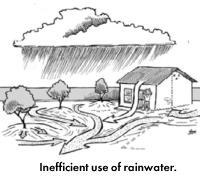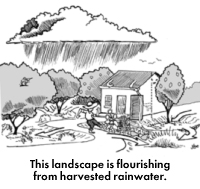 When the Monsoon clouds come and the humidity is soaring watch the rain activity around your landscape. What direction is the runoff? Where are the puddles forming? Are there areas of erosion? Historically, people relied on harvested rain water to provide water for drinking, landscape watering, and for agricultural uses. Centralized water supply systems have replaced the need to harvest water. We are encouraging people to come back to water harvesting. It is one of the oldest known gardening methods, dating back to the beginnings of agriculture. In fact, water harvesting is still used by the Tohono O’odham and Hopi tribes.
When the Monsoon clouds come and the humidity is soaring watch the rain activity around your landscape. What direction is the runoff? Where are the puddles forming? Are there areas of erosion? Historically, people relied on harvested rain water to provide water for drinking, landscape watering, and for agricultural uses. Centralized water supply systems have replaced the need to harvest water. We are encouraging people to come back to water harvesting. It is one of the oldest known gardening methods, dating back to the beginnings of agriculture. In fact, water harvesting is still used by the Tohono O’odham and Hopi tribes.
Simply put, water harvesting is the capture, diversion, and storage of rainwater for plant irrigation and other uses. It is very useful in providing water for home garden landscapes featuring desert-adapted plants.
 Many methods are available to harvest rain water for landscape use, some that are inexpensive and easy to construct. All you need to get started is rainfall and plants that require irrigation. It can be as easy as capturing runoff from rooftops and storing water in a barrel for later use. Small berms and drainages can be built to direct water to a row of trees. Crescent-shaped berms can be constructed around the base of the plant on the down-hill side on slopes for slowing and holding water. Small changes like this will help you re-contour your yard for more efficient water harvesting.
Many methods are available to harvest rain water for landscape use, some that are inexpensive and easy to construct. All you need to get started is rainfall and plants that require irrigation. It can be as easy as capturing runoff from rooftops and storing water in a barrel for later use. Small berms and drainages can be built to direct water to a row of trees. Crescent-shaped berms can be constructed around the base of the plant on the down-hill side on slopes for slowing and holding water. Small changes like this will help you re-contour your yard for more efficient water harvesting.
There are many benefits to harvesting rainwater. Rainwater harvesting is an effective water conservation tool because it provides “free” water. It also reduces off-site flooding and erosion by holding rainwater on the site. Rainwater is a clean, salt-free source of water for plants. When collected, rainwater percolates into the soil, forcing salts down and away from the root zone area. This allows for greater root growth and water uptake, which increases the drought tolerance of plants. Try it! Start simple and expand. You will be pleased with the results.
Here’s a detailed reference:


 REQUEST A QUOTE
REQUEST A QUOTE